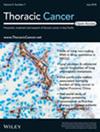Initial screening for neuronal autoantibodies and their putative impact on survival in patients with small‐cell lung cancer
IF 2.3
3区 医学
Q3 ONCOLOGY
引用次数: 0
Abstract
IntroductionSmall‐cell lung cancer (SCLC) may be associated with neuronal autoantibodies and paraneoplastic neurological syndromes. It has been suggested that neuronal autoantibodies, especially antineuronal nuclear antibody type 1 (Hu) autoantibodies, are associated with longer survival of patients with SCLC. The objective of this study was to determine the frequency and distribution of neuronal autoantibodies at the time of diagnosis of SCLC patients and assess survival rates in relation to autoimmunity.MethodsIn this retrospective study, serum from 40 patients with biopsy‐proven SCLC at the time of diagnosis was studied prior to treatment. The sera originated from a cancer registry at the Oncology Department, Vejle Hospital from 2007 to 2010. The sera were analyzed blindly to clinical status for the presence of neuronal autoantibodies. Medical records were reviewed for neurological symptoms.ResultsNeuronal autoantibodies were detected in 22/40 (55%) of the SCLC patients. A broad range of neurological symptoms was recorded in 28/40 (70%) patients, of which 14/28 (50%) were positive for neuronal autoantibodies. The most frequently detected autoantibodies were Hu (7/40, 17.5%) followed by GAD65 (6/22, 15.0%). Striational and P/Q‐ or N‐type voltage‐gated calcium channel antibodies were less common, with each found in five patients (12.5%). Eight patients (20%) had coexisting autoantibodies. Autoantibody‐positivity was not associated with survival.ConclusionNeuronal autoantibodies were at time of diagnosis found in approximately half of the treatment‐naïve SCLC patients. Neither autoantibody positivity at diagnosis nor neurological manifestations correlated with survival and their clinical importance requires further studies in larger, prospective cohorts.初步筛查神经元自身抗体及其对小细胞肺癌患者生存的影响
导言小细胞肺癌(SCLC)可能与神经元自身抗体和副肿瘤性神经综合征有关。有研究认为,神经元自身抗体,尤其是抗神经元核抗体1型(Hu)自身抗体,与SCLC患者生存期的延长有关。本研究旨在确定SCLC患者确诊时神经元自身抗体的频率和分布,并评估与自身免疫相关的生存率。这些血清来自韦勒医院肿瘤科 2007 年至 2010 年的癌症登记。对血清进行了盲法分析,以确定是否存在神经元自身抗体。结果在22/40(55%)名SCLC患者中检测到神经元自身抗体。28/40(70%)名患者出现了各种神经系统症状,其中14/28(50%)名患者的神经元自身抗体呈阳性。最常检测到的自身抗体是Hu(7/40,17.5%),其次是GAD65(6/22,15.0%)。纹状体和 P/Q- 或 N 型电压门控钙通道抗体较少见,分别在 5 名患者(12.5%)中发现。八名患者(20%)同时存在自身抗体。结论约半数未经治疗的SCLC患者在确诊时发现了神经元自身抗体。诊断时的自身抗体阳性和神经系统表现均与存活率无关,其临床重要性需要在更大规模的前瞻性队列中进一步研究。
本文章由计算机程序翻译,如有差异,请以英文原文为准。
求助全文
约1分钟内获得全文
求助全文
来源期刊

Thoracic Cancer
ONCOLOGY-RESPIRATORY SYSTEM
CiteScore
5.20
自引率
3.40%
发文量
439
审稿时长
2 months
期刊介绍:
Thoracic Cancer aims to facilitate international collaboration and exchange of comprehensive and cutting-edge information on basic, translational, and applied clinical research in lung cancer, esophageal cancer, mediastinal cancer, breast cancer and other thoracic malignancies. Prevention, treatment and research relevant to Asia-Pacific is a focus area, but submissions from all regions are welcomed. The editors encourage contributions relevant to prevention, general thoracic surgery, medical oncology, radiology, radiation medicine, pathology, basic cancer research, as well as epidemiological and translational studies in thoracic cancer. Thoracic Cancer is the official publication of the Chinese Society of Lung Cancer, International Chinese Society of Thoracic Surgery and is endorsed by the Korean Association for the Study of Lung Cancer and the Hong Kong Cancer Therapy Society.
The Journal publishes a range of article types including: Editorials, Invited Reviews, Mini Reviews, Original Articles, Clinical Guidelines, Technological Notes, Imaging in thoracic cancer, Meeting Reports, Case Reports, Letters to the Editor, Commentaries, and Brief Reports.
 求助内容:
求助内容: 应助结果提醒方式:
应助结果提醒方式:


